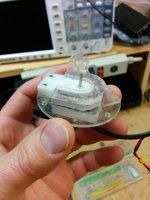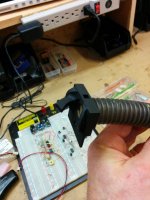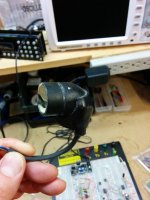Maybe a step drill?
Titanium Nitride Coated Steel Step Drill Bit Set
Have a look at this. I use one and it works well.
PeterC.
Titanium Nitride Coated Steel Step Drill Bit Set
Have a look at this. I use one and it works well.
PeterC.
So, back from the business trip and I've been thinking about this drilling thread and about drills designed for plastic. Most people don't realize how dangerous drilling soft materials like plastic can be. Just ask any machinist that has had a lathe grab in brass or aluminum. It's fast and ugly.
I mentioned to Peter that there are drills ground specifically for plastic however I only buy a specifically ground drill when I have a lot of a particular hole size to drill and I don't have that size in my shop. There is a simpler and more cost effective way to alter HSS (High Speed Steel) drills for plastic and brass. Just remember that the drill is useless for much else afterwards so it's best to buy and alter an entire set and mark the case 'for plastics only'.
The fix is simple, dull the cutting edge of a drill ground for cutting metal. This keeps the drill from screwing its way into the material as soon as the point penetrates the opposite surface. Rather than try to describe it I've located a video that lays it out plain as day.
How to Make a Twist Drill Safe for Use on Brass and Plastics - YouTube
If on the other hand you need to jig saw your plastic then the ones designed for plastic are terrific. I'f you put masking tape on both sides of plastics like Lexan you'll get very smooth edges.
I mentioned to Peter that there are drills ground specifically for plastic however I only buy a specifically ground drill when I have a lot of a particular hole size to drill and I don't have that size in my shop. There is a simpler and more cost effective way to alter HSS (High Speed Steel) drills for plastic and brass. Just remember that the drill is useless for much else afterwards so it's best to buy and alter an entire set and mark the case 'for plastics only'.
The fix is simple, dull the cutting edge of a drill ground for cutting metal. This keeps the drill from screwing its way into the material as soon as the point penetrates the opposite surface. Rather than try to describe it I've located a video that lays it out plain as day.
How to Make a Twist Drill Safe for Use on Brass and Plastics - YouTube
If on the other hand you need to jig saw your plastic then the ones designed for plastic are terrific. I'f you put masking tape on both sides of plastics like Lexan you'll get very smooth edges.
So, back from the business trip and I've been thinking about this drilling thread and about drills designed for plastic. Most people don't realize how dangerous drilling soft materials like plastic can be. Just ask any machinist that has had a lathe grab in brass or aluminum. It's fast and ugly.
.
Well that was interesting! I did look at the video, and I've certainly had that situation happen to me before. My only concern is that I have used some duller bits on plastic, and it often seems to increase the heating and melting affect, contributing to what i guess I'd call a messy "entry wound". But in all honesty I have to say that all the times when a sharp bit did grab the work like that, I usually have to admit I was getting impatient and trying to drill too fast. Would you agree?
Dubbing a drill bit for brass and plastic should not render it dull. The cutting angle is changed dramatically, but it shouldn't be rounded. It should still make a chip or chips of some sort.
BTW, "jobber length" drills will often flex more than desired. You can get "screw machine length" drills from any good tool supplier that work much better.
BTW, "jobber length" drills will often flex more than desired. You can get "screw machine length" drills from any good tool supplier that work much better.
Last edited:
Yes,
Conrad is correct.
A drill should still be "sharp" after altering the cutting angle.
Don't "round" the cutting edge.
Grind a new front angle that is just the other side of 90degrees. This makes a negative cutting angle. The -ve cutting angle gives a stronger shape to the cutting tool. It is used a lot in industry.
The youtube video mentions dulling. He is using the wrong word. He is wrong !
It suits very hard metals, as well as drilling soft materials.
Conrad is correct.
A drill should still be "sharp" after altering the cutting angle.
Don't "round" the cutting edge.
Grind a new front angle that is just the other side of 90degrees. This makes a negative cutting angle. The -ve cutting angle gives a stronger shape to the cutting tool. It is used a lot in industry.
The youtube video mentions dulling. He is using the wrong word. He is wrong !
It suits very hard metals, as well as drilling soft materials.
All drilling occurs due to angles and the design of the drill. The altering motion being used in the video is correct however and if you replicate what you 'see' in the video you get the correct result.
Drilling materials accurately is almost an art form and the physics and techniques involved with it are extensive....and not necessary in most cases. Its a simple tip to help in drilling the soft material used in this case, semantics notwithstanding. I agree that "dulling" is not the correct word to use but neither is rake, web, flute or all the other words surrounding drill theoy and while valid I would suggest that "grinding a new front angle just the other side of 90 degrees" would not help most people reading this thread.
Drilling materials accurately is almost an art form and the physics and techniques involved with it are extensive....and not necessary in most cases. Its a simple tip to help in drilling the soft material used in this case, semantics notwithstanding. I agree that "dulling" is not the correct word to use but neither is rake, web, flute or all the other words surrounding drill theoy and while valid I would suggest that "grinding a new front angle just the other side of 90 degrees" would not help most people reading this thread.
I am concerned that altering a drill for the BETTER is probably beyond what I'd want to attempt, and almost certainly something I wouldn't get right the first few attempts. But I am finding though that if I drill the plastic at a medium speed (maybe 1800), and remain patient about drilling slowly, it works pretty well and remains accurate without the work being grabbed or pulled off center. So maybe this is a point of interest, but a tangent in the grand scheme of my project that I don't need to follow for now.
At least one poster mentioned that using wood bits for plastic is an exercise in futility.
Hi,
No. I said using wood drills into steel is an "exercise in futility".
rgds, sreten.
You asked about a center drill... Here's what an image search on Bing brings up:

The point of the center drill is that it doesn't flex and run off center as you're starting the hole. They're used a lot on milling machines where you rely on the X/Y table to find the hole location rather than a center punch mark.
~Tom

The point of the center drill is that it doesn't flex and run off center as you're starting the hole. They're used a lot on milling machines where you rely on the X/Y table to find the hole location rather than a center punch mark.
~Tom
You asked about a center drill... Here's what an image search on Bing brings up:
The point of the center drill is that it doesn't flex and run off center as you're starting the hole. They're used a lot on milling machines where you rely on the X/Y table to find the hole location rather than a center punch mark.
~Tom
Possibly dumb question. These bits all have two ends. Is this to provide a second when one wears out, or are the two ends intended for different materials. Also, high or low rpm reccomended for these (when drilling ABS). Considering how inexpensive sets of these are on ebay, I might as well get a set.or two.
The double end is just for efficiency and not for different materials. They are typically used to start a drill hole as mentioned. The steel in them is very tough which also means brittle. I've broken dozens of these in lathes and drill presses. They are in constant use in machine shops however they would be a waste of money for most hobby jobs IMO. But that said they are useful and you might love them.
You really need to find yourself a drill speed chart if you plan to do accurate drilling. I have several machinists 'pocket handbooks' in my shop. They are crammed full of things like tap drill sizes, speed charts, material information, formulae etc. Excellent reference books and the go to source for just about anything related to shop work. You can find one at your local machine tool supplier.
You really need to find yourself a drill speed chart if you plan to do accurate drilling. I have several machinists 'pocket handbooks' in my shop. They are crammed full of things like tap drill sizes, speed charts, material information, formulae etc. Excellent reference books and the go to source for just about anything related to shop work. You can find one at your local machine tool supplier.
many electric hand drills have a selectable two speed capability. Fast and far too fast, typically 2000rpm and 3000rpm.
These >1500rpm speeds generally only suit very small drills, that don't take kindly to misalignment of unskilled users.
I bought a Bosch with 400rpm and 1100rpm specially to suit the drill sizes I was likely to use in a hand drill.
I used it mostly at 400rpm setting and the massive torque available (hold on very tight) from the reduction gear ratio meant I could drill upto 5/8ths" into mild steel. It is now more than 20years old and has never broken down and never overheated.
BTW,
the variable speed trigger fitted to some drills reduces the output torque as well as the motor speed.
The reduced motor speed massively reduces the cooling provided by the now too slow fan. The reduced torque increases the current demand of the motor in trying to drill at the electronically reduced speed.
The combined effect of reduced cooling and increased current kills hand drill motors.
Battery powered motors generally run at much lower speeds and do make for good hand drills with typical drill sizes.
These >1500rpm speeds generally only suit very small drills, that don't take kindly to misalignment of unskilled users.
I bought a Bosch with 400rpm and 1100rpm specially to suit the drill sizes I was likely to use in a hand drill.
I used it mostly at 400rpm setting and the massive torque available (hold on very tight) from the reduction gear ratio meant I could drill upto 5/8ths" into mild steel. It is now more than 20years old and has never broken down and never overheated.
BTW,
the variable speed trigger fitted to some drills reduces the output torque as well as the motor speed.
The reduced motor speed massively reduces the cooling provided by the now too slow fan. The reduced torque increases the current demand of the motor in trying to drill at the electronically reduced speed.
The combined effect of reduced cooling and increased current kills hand drill motors.
Battery powered motors generally run at much lower speeds and do make for good hand drills with typical drill sizes.
Last edited:
Andrew (and copper) I'll be using a drill press that I have fitted with an X/Y table to create a poor mans milling machine, and it has 5 variations from 700-3000RPM. I've used the high (3000) RPM setting with really good results with some pretty tiny two-flute milling bits, to cut rectangles into these same plastic cases. But it seems a middle of the road speed is better for drilling holes in the soft plastic. To slow also seems to make the work tend wander more.
That sounds like an excellent setup. When I got this thread update I was reaming and squaring the ends of 3 inch ABS pipe on a drill press for a project. I do a lot of plastic machining on a drill press using dremmel cutters. I took some quick shots of some stuff done entirely that way. I'll resize them and post.
Here are some samples of what you can do on a simple drill press using dremmel cutters and a fence. These were constructed as part of an infrared controlled feed system. The motor mount fits in the bottom of a hopper and drives a set of rotating paddles. The tube adapter mounts to the hopper and accepts the delivered product. The feed neck has an infrared emitter and detector in it to control the solid state drive circuit. All parts are hand machined plastic.
http://www.diyaudio.com/forums/atta...392921690stc=1&d=1392921690stc=1&d=1392921690
http://www.diyaudio.com/forums/atta...392921690stc=1&d=1392921690stc=1&d=1392921690
Attachments
Sounds like a pretty interesting project. Nice job on that clear circular piece. Amazing the way projects mushroom, forcing us to develop dozens of new skills along the way!
The X/Y table/vise I got was so rediculosly chep on E-bay, that I thought for sure it would turn into a big frustration to use. It did require a little adjusting and tweaking, but in the end it worked great, and I can't imaging how I did without one of these things for so long!
The X/Y table/vise I got was so rediculosly chep on E-bay, that I thought for sure it would turn into a big frustration to use. It did require a little adjusting and tweaking, but in the end it worked great, and I can't imaging how I did without one of these things for so long!
- Status
- This old topic is closed. If you want to reopen this topic, contact a moderator using the "Report Post" button.
- Home
- Design & Build
- Construction Tips
- can't drill a set of aligned holes to save my life!


